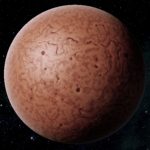System Specs:
- Stellar Mass: 0.76 Sol Masses
- Stellar Class: K
- Luminosity: N/A Sol
- Planets: 5
- Moons: 0
- Asteroid Belts: 0
- Asteroids: 0
- Objects: 0

Elysta’s terrestrial worlds have an abundance of resources and no complex native life apart from the usual mining operations. Other than a Prothean wreck in one of its gas giants and a Spectre investigating shady local business dealings, there are no other noteworthy discoveries in the system.
–
Planets Directory:
- Saleas
- Zeona
- Odasst
- Hesano
- Melile
–
Saleas:

- Orbital Distance: 0.4 AU
- Orbital Period: 0.3 Earth-years
- Keplerian Ratio: 0.711
- Radius: 3,485 km
- Day Length: 0.3 Earth-hours
- Atmospheric Pressure: Trace atm
- Surface Temp: 138 °C
- Surface Gravity: 0.32 g
- Mass: 0.095 Earth-masses
Saleas’ cratered surface is ancient; parts of the highlands have been unchanged for nearly three billion years. The layers of overlapping craters stand as testament to the violence of the system’s creation. Saleas is tidally locked to Elysta and has a trace atmosphere of krypton and xenon, with helium constantly “blowing in” via solar winds.
–
Zeona:

- Orbital Distance: 0.64 AU
- Orbital Period: 0.6 Earth-years
- Keplerian Ratio: 0.728
- Radius: 4,734 km
- Day Length: 49.6 Earth-hours
- Atmospheric Pressure: 0.55 atm
- Surface Temp: 68 °C
- Surface Gravity: 0.57 g
- Mass: 0.312 Earth-masses
Zeona has a thin atmosphere of sulfur dioxide and trioxide, created by volcanic outgassing. There are traces of water vapor in the atmosphere, but over the last five centuries of observation particle counts have decreased 4%.
While not habitable by any spacefaring species, there is an abundance of native sulfur-devouring bacteria that thrives around the world’s many volcanic vents. Interestingly, these bacterium bear genetic similarities to the native life of Illium, suggesting either a “panspermia” spread of microbes via asteroids, or accidental contamination of the original environment by careless spacefarers.
–
Odasst:

- Orbital Distance: 0.96 AU
- Orbital Period: 1.1 Earth-years
- Keplerian Ratio: 0.731
- Radius: 6,882 km
- Day Length: 28.3 Earth-hours
- Atmospheric Pressure: 1.1 atm
- Surface Temp: 20 °C
- Surface Gravity: 1.2 g
- Mass: 1.387 Earth-masses
- Colony: Jorass (capital), population 11,640
Odasst has an abundance of heavy metals and radioactives. It is heavily exploited by mining concerns based on Illium. Forty-three years ago, a Council Spectre arrived to investigate reports that the businesses were selling platinum – a strategic metal – to pirate groups in the Terminus Systems. The results of the investigation were never released, but no deaths were reported.
–
Hesano:

- Orbital Distance: 1.82 AU
- Orbital Period: 2.7 Earth-years
- Keplerian Ratio: 0.827
- Radius: 34,035 km
- Day Length: 13.1 Earth-hours
- Atmospheric Pressure: N/A atm
- Surface Temp: N/A °C
- Surface Gravity: N/A g
- Mass: N/A Earth-masses
- Satellites: >1
Hesano is a standard hydrogen-helium gas giant. Two hundred years ago, an independent volus prospector found the mangled wreck of a Prothean starship trapped within the trailing Lagrange point. Few artifacts from the wreckage have been recovered.
The prospector, Lumen Kreop, was canny enough to keep the hulk’s existence to himself. He sold its location to a turian paleotechnology firm for nearly a million credits. Since then, Hesano’s Lagrange points, rings, and moons have been combed over by fortune hunters seeking to strike it rich the same way. Thus far, no additional artifacts have been recovered.
–
Melile:

- Orbital Distance: 3.1 AU
- Orbital Period: 6.1 Earth-years
- Keplerian Ratio: 0.801
- Radius: 28,684 km
- Day Length: 8.6 Earth-hours
- Atmospheric Pressure: N/A atm
- Surface Temp: N/A °C
- Surface Gravity: N/A g
- Mass: N/A Earth-masses
- Satellites: 23
Melile is a common ammonia-methane ice giant with 23 moons. It has no particularly distinctive features.
–
–
video






